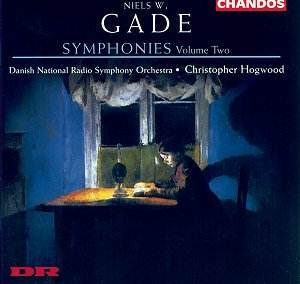I listened to the 4th Symphony first and
thought what an entrancing work this is. After the briefest of introductions
the Allegro Vivace starts almost imperceptibly with a couple of drone
basses that still seem to be in the previous tempo, but it is soon swirling
away and generates much vitality (and some whole-hearted if at times
scrappy playing), with some enchanting scoring in second subject territory
and the clearest of designs. The slow movement has much warm, romantic
feeling and, again, some delightful scoring. If I began wondering whether
the theme itself was quite as memorable as those of the first movement,
the brief movement was practically over by that time. The featherdown
opening of the scherzo had me pricking up my ears; this is an absolute
charmer. The finale? I have remarked before that Gade at times spoilt
an otherwise good symphony with a four-square finale. Exuberant swirlings
rather than full-scale themes are the name of the game here, with just
a touch of gentler contrasting material to stop it from becoming over-emphatic.
If you look on this as a late example of a Haydn-type symphony where
the weight is in the first movement and the finale is a brilliant send-off,
then the symphony is wholly convincing. I was also left puzzled that
I had bought, and listened to, the Järvi version when it came out,
but I didnít remember having been struck by it in this way, but more
of that in a moment.
About the 7th I was not so sure. The first
movement is a warm-hearted affair, with some rich-hued scoring and a
clear shape (though I felt Hogwood never obtained a properly defined
enunciation of the principal theme, the repeated notes of which gel
into one another). The second and third seemed to lack distinctive material
and rather outstayed their welcome. The finale presents a wider range
of themes than in other such movements from Gade, but fails to marshal
them into a single culminating statement.
I also felt that Hogwood was rather hustling things,
and that the symphony might have said rather more if it had been given
space for its themes really to speak. Imagine my dismay when I got the
Jarvi alternative down and saw that his timings are shorter still in
every movement. But itís not quite like that. With a leaner orchestral
sound, very taut phrasing and an unerring sense of pace, Järvi
actually makes the symphony convincing in all four movements. This is
a masterly piece of conducting.
Järviís 4th is no less so, but in this
case Hogwoodís less careful but buoyant approach seems to tap better
the natural exuberance of the piece. The Concert Overture no. 3 receives
a first recording. It is an impressive, bardic-toned piece, perhaps
a little over-insistent; maybe it would have responded better to Järvi-treatment.
This is one of those moments when the critic feels
rather helpless. It looks as though you will need Järvi in no.
7 and Hogwood in no. 4. The trouble is, both cycles are coupled differently,
so you will have to opt for one or other conductor all through; in which
case Järvi remains unchallenged since my slight preference for
Hogwood in no. 4 is nothing compared to my very definite preference
for Järvi in no. 7. Also BISís cleaner sound is preferable to Chandosís
more reverberant, sometimes brass-heavy textures.
Christopher Howell

![]() Danish National Radio Symphony
Orchestra/Christopher Hogwood
Danish National Radio Symphony
Orchestra/Christopher Hogwood ![]() CHANDOS CHAN 9957 [67.15?]
CHANDOS CHAN 9957 [67.15?]